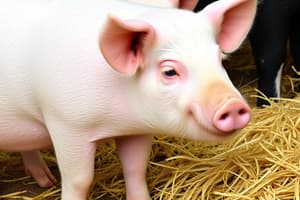Podcast
Questions and Answers
What are the different types of swine?
What are the different types of swine?
- Meat type hog
- Bacon type hog
- Both meat type and bacon type hog (correct)
- None of the above
What are some common restraint methods used with swine?
What are some common restraint methods used with swine?
Hurdles, paddles, physical restraint, hog snares, snubbing ropes, and troughs.
What are some factors used in selecting swine?
What are some factors used in selecting swine?
Offspring from large litters, excellent muscle and back fat readings, reaching adult size by 1 year of age, no genetic flaws, medium to large body structure, and easy to handle.
How should a sow be managed during farrowing?
How should a sow be managed during farrowing?
Describe the nutritional requirements of swine.
Describe the nutritional requirements of swine.
What are the production system types in swine programs?
What are the production system types in swine programs?
What is the importance of swine production?
What is the importance of swine production?
What management practices are necessary with young pigs?
What management practices are necessary with young pigs?
What is the difference between a barrow and a stag?
What is the difference between a barrow and a stag?
What are the requirements of an SPF herd?
What are the requirements of an SPF herd?
Study Notes
Types of Swine
- Two primary categories: meat type hogs and bacon type hogs.
- Meat type hogs yield pork and are muscular, suitable for various cuts such as hams and loins.
- Bacon type hogs are characterized by higher fat content.
Restraint Methods for Swine
- Common methods include hurdles, paddles, physical restraint, hog snares, snubbing ropes, and troughs.
- Physical restraint can involve holding a pig upside down by grasping a rear leg.
Selection Factors for Swine
- Preferred traits: large litters, excellent muscle and back fat characteristics.
- Ideal swine reach adult size by one year, have no genetic flaws, and medium to large body structures.
Management of Sows During Farrowing
- Sows require individual confinement with hands-on care, monitoring closely during labor.
- Difficult farrowing may necessitate labor induction between days 111 to 113.
- Nesting materials like straw and hygiene practices are critical to reduce piglet injuries.
Nutritional Requirements of Swine
- Daily feed intake should be 4-5 pounds, with variations based on age and production purpose.
- Young boars require more nutrients than adults, while breeding sows need increased feed in late gestation.
Swine Production System Types
- Common systems include: feeder pigs, finishing systems, and farrow to finish systems.
Importance of Swine Production
- Swine are vital meat producers, with pork referred to as "the other white meat," known for its tenderness.
- Approximately 100 million pigs exist in the U.S., making swine production the second largest livestock industry in North America.
Management Practices for Young Pigs
- Essential practices include needle teeth trimming, castration, tail docking, ear notching, vaccinations, umbilical cord treatment, and de-worming.
Differences Between Barrow and Stag
- A barrow is a castrated young male pig, while a stag is castrated after reaching maturity.
Requirements for an SPF Herd
- Specific Pathogen Free (SPF) herds are disease-free at birth, raised in aseptic environments, genetically sound, and vaccinated against common diseases.
Studying That Suits You
Use AI to generate personalized quizzes and flashcards to suit your learning preferences.
Description
This quiz covers the key concepts from Chapter 21 on swine breed identification and production management. It focuses on the two main types of swine: meat type and bacon type, along with their characteristics and uses in production. Test your knowledge of swine breeds and their management techniques!




